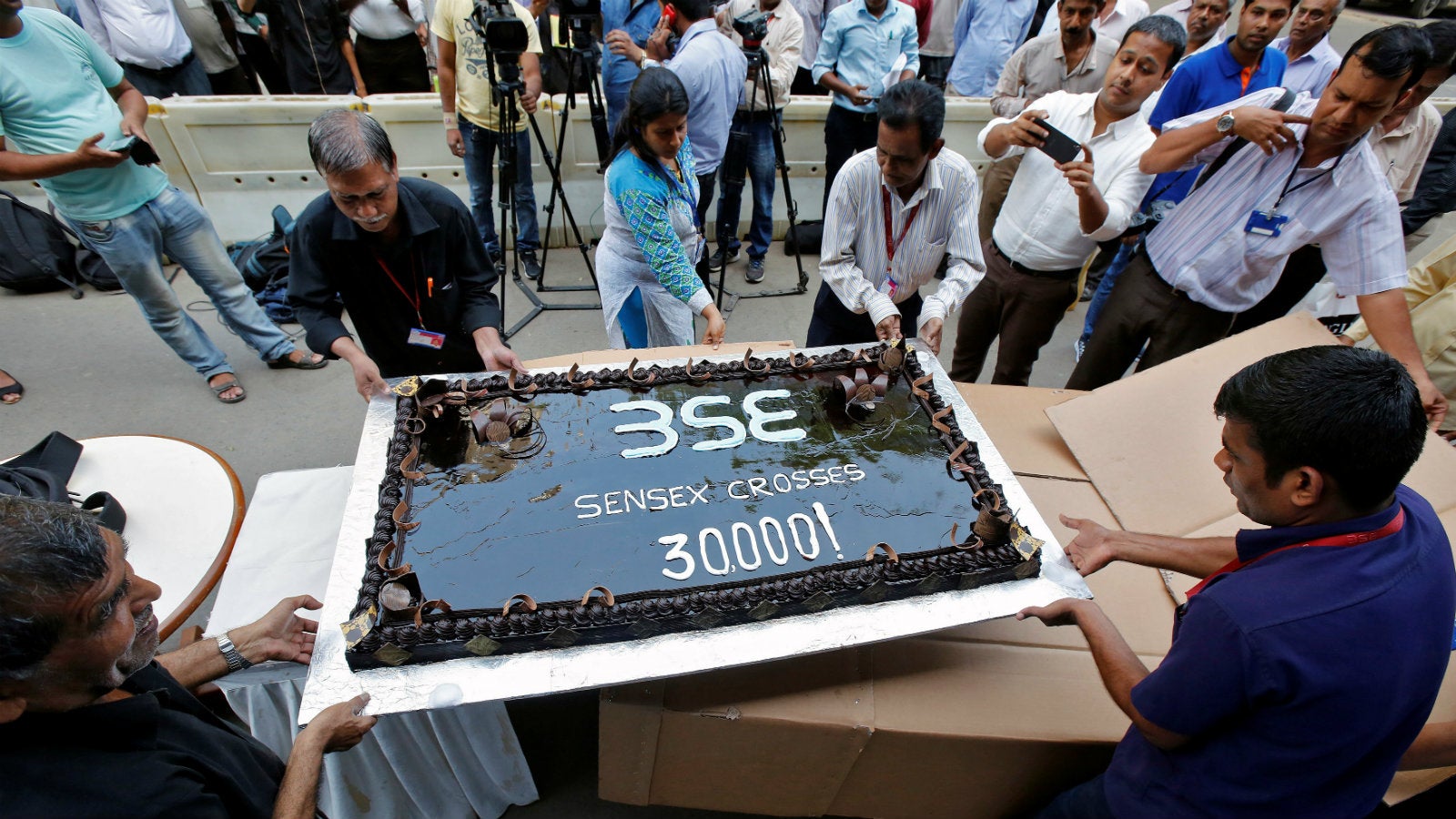Don’t let the fabulous week Indian markets just had distract you from the glaring cracks in the economy
On April 26, India’s Sensex—BSE’s benchmark equity index—closed at its highest level ever at 30,133.35 points. The index has risen some 1.3% during this week (April 24-27) alone. Nifty 50, NSE’s key index, too, ended at a record high on that day. At the BSE office in Mumbai, India’s financial capital, brokers celebrated the great rally with balloons and cake.


On April 26, India’s Sensex—BSE’s benchmark equity index—closed at its highest level ever at 30,133.35 points. The index has risen some 1.3% during this week (April 24-27) alone. Nifty 50, NSE’s key index, too, ended at a record high on that day. At the BSE office in Mumbai, India’s financial capital, brokers celebrated the great rally with balloons and cake.
What is fuelling this bull run? Positive sentiment and ample money to invest, say experts.
“The economy is getting into an execution mode and there’s a feel good factor among corporates,” Deven Choksey, CEO and managing director at KR Choksey Shares and Securities said. While the government has slowly begun executing tax and labour reforms, Choksey believes the speed of execution will only increase.
“There’s also a lot of liquidity in the domestic market, which means a lot of disposable income is coming to the markets” Choksey explained. Moreover, he believes this rally is just the beginning of a high-growth period.
“Corporate earnings until now haven’t disappointed and financial savings are coming into equity markets,” Dipen Shah, senior vice-president, PCG research at Kotak Securities, said. Post-demonetisation, many Indians have turned to mutual funds and equities to park their savings. Now, the annual monsoon rains will be key in sustaining this optimism, Shah said.
Some observers even suggest that India’s equity markets will continue in this stride for the next few years. ”Factors such as structural shift towards digitisation of the economy, coupled with increased focus on channelisation of financial savings, given the relative attractiveness of equity versus other asset classes, would keep the Indian financial market buoyant for the next three to five years,” Pankaj Pandey, head of research at ICICI Direct, an online investment services, said in a note on April 26.
Yet, this exuberance seems to be masking many problems in the economy.
The economy paradox
The challenges to India’s economy are too big to ignore. For one, private investment still hasn’t picked up.
“Tepid investment is the economy’s main weak spot and a challenge for policy makers,” said Angela Bouzanis, senior economist at Barcelona-based FocusEconomics. India’s private investment cycle still needs to pick up; the industrial sector is struggling to operate at optimum capacity.
Economists are also still circumspect about the GDP numbers since they got a boost following a change in the method of calculation. “A healthy dose of scepticism is needed. Doubts over the true underlying momentum of the economy have existed since the government changed its GDP methodology in 2015 and discrepancies between GDP figures and other economic indicators are a cause for concern, clouding the on-the-ground picture,” Bouzanis added in an email response to Quartz. For months, industrial production and manufacturing growth have been weak. Additionally, many infrastructure projects across the country remain stalled or are progressing at a snail’s pace, a threat to the economic growth.
Besides, India’s banking sector isn’t looking up. Corporate debt, on one hand, is ballooning—fuelling fears of defaults—and existing non-performing assets are bearing down balance-sheets. The sector’s health is “a cause for concern, amid high levels of non-performing assets,” Bouzanis said.
There are bigger and longer-term issues, too; weak state finances, for instance. A slew of policy measures by the Narendra Modi government and the various state administrations, such as prohibition, GST, and farm-loan waivers, could shrink revenue streams. ”Finances of state governments also warrant attention and here the trend has turned unfavourable in recent years…States’ spending commitments have risen while revenues stagnate,” DBS Group Research said in an April 12 report.
Meanwhile, concerns over jobless growth are getting stronger. Job growth in labour-intensive sectors has been slow in recent years. The number of white-collar jobs in sectors such as IT and telecom, too, is seeing weak growth. With the size of the young Indian workforce estimated to be the world’s largest by 2020, it will be difficult for the Modi government to plug this demand-supply gap in jobs. “Job creation is vital for any emerging economy because jobs are the passport from poverty to working class, from the informal to the formal economy,” said Lourdes Casanova, a senior lecturer at Cornell University’s S C Johnson School of Management. “For a country where poverty is so pervasive, growth without job creation is not real growth,” she added.
But, for now, the stock market seems to be overlooking these weak fundamentals and partying hard.